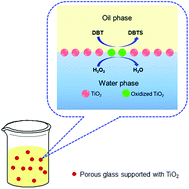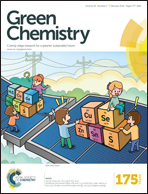Oxidative desulfurization of DBT with H2O2 catalysed by TiO2/porous glass†
Abstract
Aimed at ultra-deep oxidative desulfurization (ODS) of dibenzothiophene (DBT) and 4,6-dimethyldibenzothiophene (4,6-DMDBT) to control air pollution, we specially designed and prepared porous glass supported with TiO2 nanoparticles acting as an amphiphilic catalyst. Hydrogen peroxide which is considered as the “green” oxidant was used, and for the extreme liquid–liquid phase ratio (usually larger than 1500) reaction system, a pore volume of 0.19 mL g−1 of the catalyst provides enough space for the storage of hydrogen peroxide. The as-prepared catalyst offers a high interfacial surface area of 116.9 m2 g−1 and enhances the reaction by facilitating the mass transfer. The mono-dispersed TiO2 exhibited good crystallinity. The mean diameter varied from 2.1 to 7.8 nm with the loading amount increasing from 1.27 wt% to 9.85 wt%. The catalyst showed high activity and good stability for producing ultra-clean fuels: 100% conversion was obtained within 2 min and the conversion just decreased from 100.0 ± 1.0% to 94.3 ± 0.6% after 5 cycles. Overall, this new reusable catalyst provided an alternative for highly efficient ultra-deep desulfurization in a green way.


 Please wait while we load your content...
Please wait while we load your content...